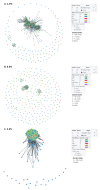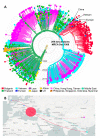Molecular Epidemiological Analysis of the Origin and Transmission Dynamics of the HIV-1 CRF01_AE Sub-Epidemic in Bulgaria
- PMID: 33467166
- PMCID: PMC7829743
- DOI: 10.3390/v13010116
Molecular Epidemiological Analysis of the Origin and Transmission Dynamics of the HIV-1 CRF01_AE Sub-Epidemic in Bulgaria
Abstract
HIV-1 subtype CRF01_AE is the second most predominant strain in Bulgaria, yet little is known about the molecular epidemiology of its origin and transmissibility. We used a phylodynamics approach to better understand this sub-epidemic by analyzing 270 HIV-1 polymerase (pol) sequences collected from persons diagnosed with HIV/AIDS between 1995 and 2019. Using network analyses at a 1.5% genetic distance threshold (d), we found a large 154-member outbreak cluster composed mostly of persons who inject drugs (PWID) that were predominantly men. At d = 0.5%, which was used to identify more recent transmission, the large cluster dissociated into three clusters of 18, 12, and 7 members, respectively, five dyads, and 107 singletons. Phylogenetic analysis of the Bulgarian sequences with publicly available global sequences showed that CRF01_AE likely originated from multiple Asian countries, with Vietnam as the likely source of the outbreak cluster between 1988 and 1990. Our findings indicate that CRF01_AE was introduced into Bulgaria multiple times since 1988, and infections then rapidly spread among PWID locally with bridging to other risk groups and countries. CRF01_AE continues to spread in Bulgaria as evidenced by the more recent large clusters identified at d = 0.5%, highlighting the importance of public health prevention efforts in the PWID communities.
Keywords: HIV-1; circulating recombinant forms; drug resistance; molecular epidemiology; prevention; transmission clusters; transmission dynamics.
Conflict of interest statement
The authors declare no conflict of interest. The funding sponsors had no role in the design of the study; in the collection, analyses, or interpretation of data; in the writing of the manuscript, and in the decision to publish the results.
Figures



Similar articles
-
Molecular Epidemiology of the HIV-1 Subtype B Sub-Epidemic in Bulgaria.Viruses. 2020 Apr 14;12(4):441. doi: 10.3390/v12040441. Viruses. 2020. PMID: 32295123 Free PMC article.
-
Molecular characteristic of HIV-1 CRF01_AE in Nanjing from 2015 to 2017.Infect Genet Evol. 2019 Nov;75:104038. doi: 10.1016/j.meegid.2019.104038. Epub 2019 Sep 11. Infect Genet Evol. 2019. PMID: 31520786
-
Origin and spread of HIV-1 in persons who inject drugs in Bulgaria.Infect Genet Evol. 2016 Dec;46:269-278. doi: 10.1016/j.meegid.2016.05.029. Epub 2016 May 21. Infect Genet Evol. 2016. PMID: 27221346 Free PMC article.
-
Global and regional epidemiology of HIV-1 recombinants in 1990-2015: a systematic review and global survey.Lancet HIV. 2020 Nov;7(11):e772-e781. doi: 10.1016/S2352-3018(20)30252-6. Lancet HIV. 2020. PMID: 33128904
-
Molecular epidemiology to aid virtual elimination of HIV transmission in Australia.Virus Res. 2024 Mar;341:199310. doi: 10.1016/j.virusres.2024.199310. Epub 2024 Jan 11. Virus Res. 2024. PMID: 38185332 Free PMC article. Review.
Cited by
-
Distinct Molecular Epidemiology, Transmission Patterns, and Resistance Mutations of HIV-1 Subtypes A1, A6, and A7 in Bulgaria.Microorganisms. 2025 May 12;13(5):1108. doi: 10.3390/microorganisms13051108. Microorganisms. 2025. PMID: 40431281 Free PMC article.
-
Identifying HIV-1 Transmission Clusters in Uzbekistan through Analysis of Molecular Surveillance Data.Viruses. 2022 Jul 29;14(8):1675. doi: 10.3390/v14081675. Viruses. 2022. PMID: 36016298 Free PMC article.
-
Transmitted HIV Drug Resistance in Bulgaria Occurs in Clusters of Individuals from Different Transmission Groups and Various Subtypes (2012-2020).Viruses. 2023 Apr 10;15(4):941. doi: 10.3390/v15040941. Viruses. 2023. PMID: 37112921 Free PMC article.
-
Characterizing HIV-1 transmission by genetic cluster analysis among newly diagnosed patients in the China-Myanmar border region from 2020 to 2023.Emerg Microbes Infect. 2024 Dec;13(1):2409319. doi: 10.1080/22221751.2024.2409319. Epub 2024 Sep 30. Emerg Microbes Infect. 2024. PMID: 39315943 Free PMC article.
-
The origin, dissemination, and molecular networks of HIV-1 CRF65_cpx strain in Hainan Island, China.BMC Infect Dis. 2024 Mar 1;24(1):269. doi: 10.1186/s12879-024-09101-w. BMC Infect Dis. 2024. PMID: 38424479 Free PMC article.
References
-
- Hemelaar J., Elangovan R., Yun J., Dickson-Tetteh L., Fleminger I., Kirtley S., Williams B., Gouws-Williams E., Ghys P.D., Abimiku A.G., et al. Global and regional molecular epidemiology of HIV-1, 1990–2015: A systematic review, global survey, and trend analysis. Lancet Infect. Dis. 2019;19:143–155. doi: 10.1016/S1473-3099(18)30647-9. - DOI - PubMed
Publication types
MeSH terms
LinkOut - more resources
Full Text Sources
Other Literature Sources
Medical
Molecular Biology Databases

